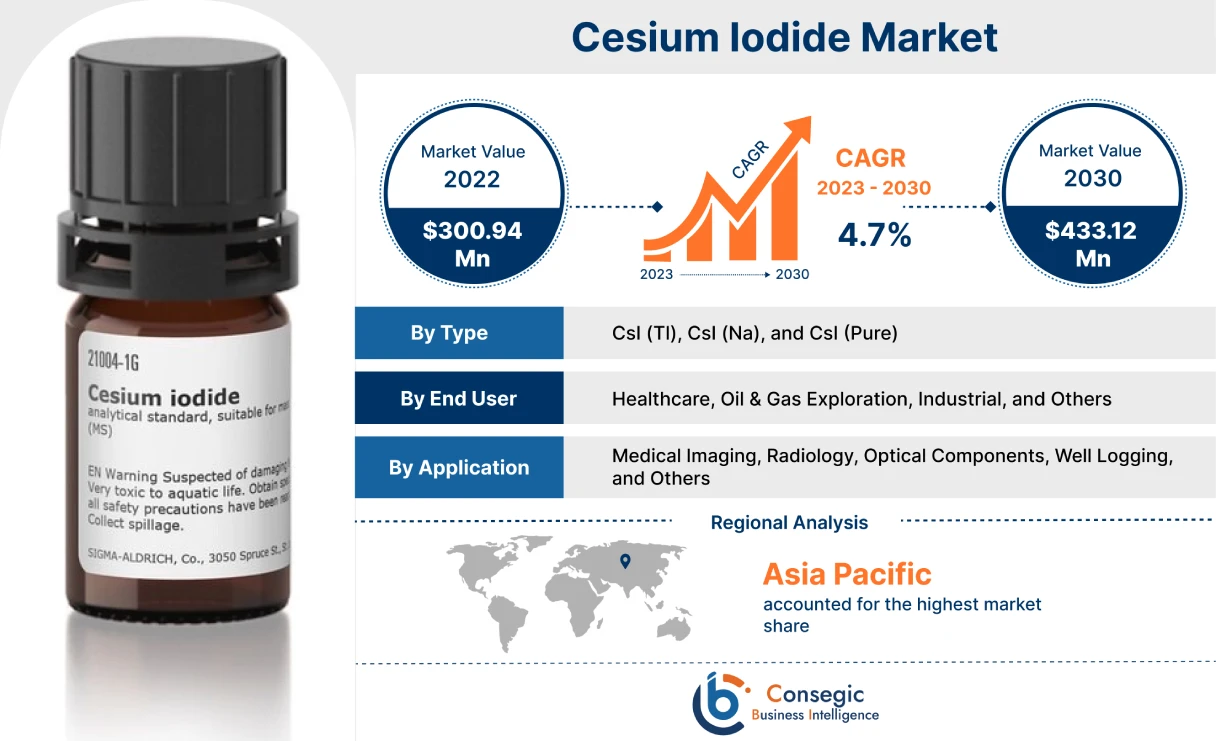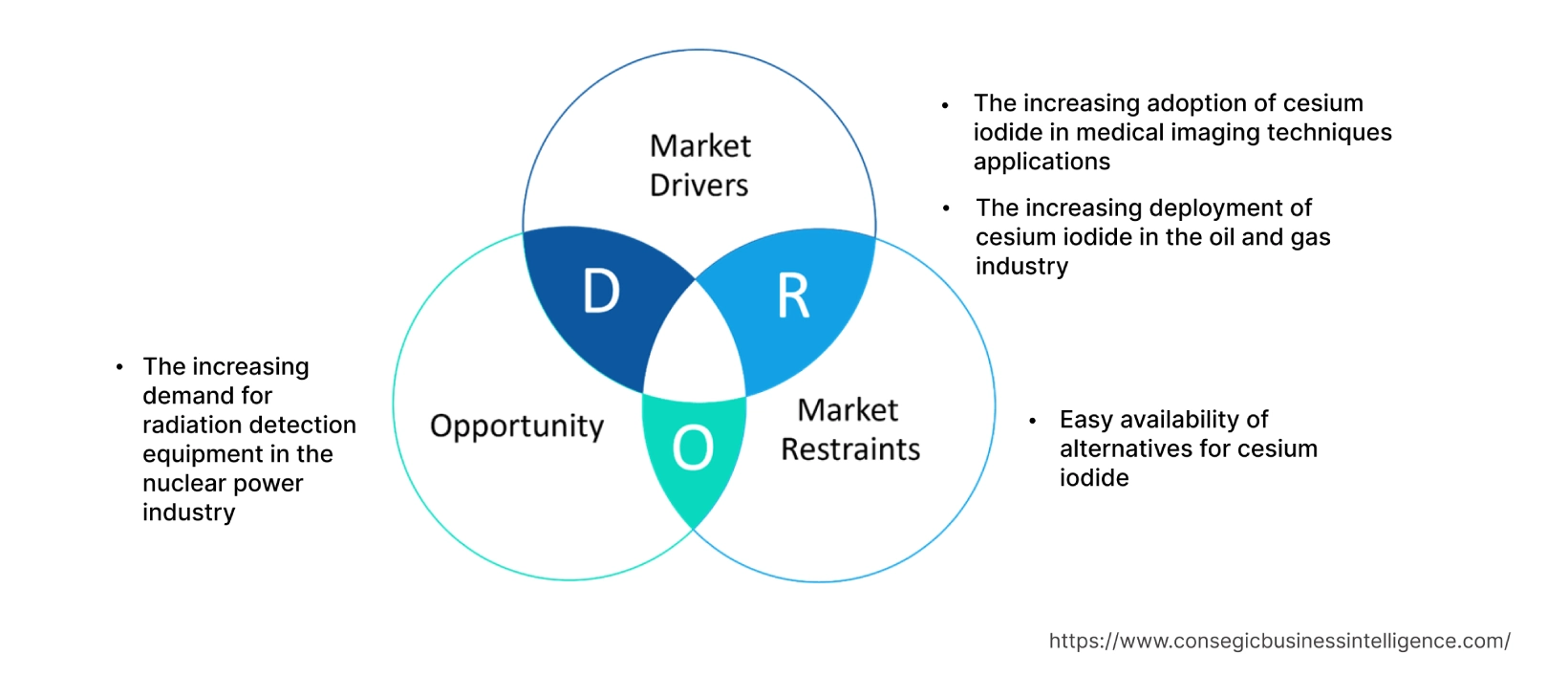- Summary
- Table Of Content
- Methodology
Cesium Iodide Market Size :
Consegic Business Intelligence analyzes that the cesium iodide market size is growing with a CAGR of 4.7% during the forecast period (2023-2030), and the market is projected to be valued at USD 433.12 Million by 2030 from USD 300.94 million in 2022.
Cesium Iodide Market Scope & Overview:
Cesium iodide is a chemical compound that is composed by two elements namely cesium and iodide. Cesium iodide is a white crystalline powder that is soluble in water and has a melting point of 621° C. The compound is commonly utilized in scintillation detectors, which are further employed for the accurate detection of ionizing radiation. In addition, cesium iodide is deployed in the manufacturing process of optical windows, lenses, and prisms to ensure high refractive index and low dispersion.
Cesium Iodide Market Insights :
Key Drivers :
The increasing adoption of cesium iodide in medical imaging techniques applications
Cesium iodide is employed in medical imaging and radiation therapy. Cesium iodide is a vital diagnostic and treatment tool which widely used in the healthcare industry. Medical imaging techniques such as X-ray, CT, and PET require radiation detectors to detect the radiation emitted by a patient's body. Cesium iodide is used as the input phosphor of an X-ray image intensifier tube found in fluoroscopy equipment. The increasing incidence of cancer and other diseases requiring medical imaging and detection therapy drives the demand for cesium iodide. For instance, according to the National Library of Medicine, in 2022, 1,918,030 new cancer cases were reported in the U.S. Hence, the rising demand for medical imaging techniques is boosting the revenue growth of cesium iodide at the global level.
The increasing deployment of cesium iodide in the oil and gas industry
Cesium iodide is a transparent crystal that has a high refractive index. As a result, cesium iodide (CsI (TI)) is extensively used in well-logging activities in the oil & gas industry. The increasing oil & gas exploration activities with the usage of cesium iodide are propelling the market growth. For instance, in December 2022, Kuwait and Saudi Arabia announced their plans for the development of the Durra offshore gas field. The company will invest USD 70 million in the project. Therefore, the wide scope of applications in the oil and gas industry is propelling the growth of the cesium iodide market.
Key Restraints :
Easy availability of alternatives for cesium iodide
The presence of various other materials such as cadmium telluride and cadmium zinc telluride is restraining the growth of the market. These materials are used for radiation detection and imaging applications. For instance, alternative materials such as cadmium telluride and cadmium zinc telluride offer advantages such as higher energy resolution, better spatial resolution, and lower noise levels. The availability of these alternatives coupled with their increasing adoption in various applications is posing a bottleneck for the growth of the cesium iodide market.
Future Opportunities :
The increasing demand for radiation detection equipment in the nuclear power industry
Cesium iodide is widely used in radiation detection equipment such as scintillators, to detect and measure radiation levels in nuclear power plants and other facilities. Cesium iodide is preferred for radiation application due to its high sensitivity, high energy resolution, and fast response time. For instance, in January 2023, Candu Energy Inc. formed a partnership with Darlington New Nuclear Project for the development of the GEH BWRX-300 Small Modular Reactor (SMR). The construction of the project is anticipated to be completed by 2029. Thus, with the increasing demand for nuclear power as a source of energy and rising concerns about nuclear safety, the demand for radiation equipment is expected to increase over the forecast period.
Cesium Iodide Market Report Insights :
| Report Attributes | Report Details |
| Study Timeline | 2017-2030 |
| Market Size in 2030 | USD 433.12 Million |
| CAGR (2023-2030) | 4.7% |
| By Type | CsI (Tl), CsI (Na), and CsI (Pure) |
| By Application | Medical Imaging, Radiology, Optical Components, Well Logging, and Others |
| By End User | Healthcare, Oil & Gas Exploration, Industrial, and Others |
| By Region | North America, Europe, Asia-Pacific, Latin America, and Middle East & Africa |
| Key Players | TCI Chemicals Pvt. Ltd., Merck KGaA, BERKELEY NUCLEONICS CORPORATION, Radiation Monitoring Devices, Amcrys, Hamamatsu Photonics K.K., Scintacor, Saint Gobain S.A., EPIC Crystal Company Limited, and Shanghai SICCAS |
Cesium Iodide Market Segmental Analysis :
By Type :
The type segment is categorized into CsI (Tl), CsI (Na), and CsI (Pure). In 2022, the CsI (Tl) segment accounted for the highest market share of 48.05% in the overall cesium iodide market, due to its wide scope of applications in healthcare applications, including X-ray. This, in turn, is contributing to the growth of the market. In addition, the increasing adoption of CsI (TI) in radiation isotope identification devices and environmental monitoring is also contributing to the growth of the market. For instance, Amcrys offers Thallium doped Cesium Iodide CsI (Tl) that has good radiation hardness and high mechanical hardness. Hence, the widespread use of CsI (TI) across various applications is driving the growth of the segment.
Moreover, the CsI (Na) segment is expected to register the fastest CAGR in the cesium iodide market. The increasing adoption of CsI (Na) in well-logging applications in oil & gas exploration activities is anticipated to accelerate the demand for cesium iodide. For instance, according to the International Labor Organization, the total global trade of petroleum gas in 2020 was valued at USD 217 billion. Therefore, the increasing oil & gas industry is expected to drive the growth of the segment.
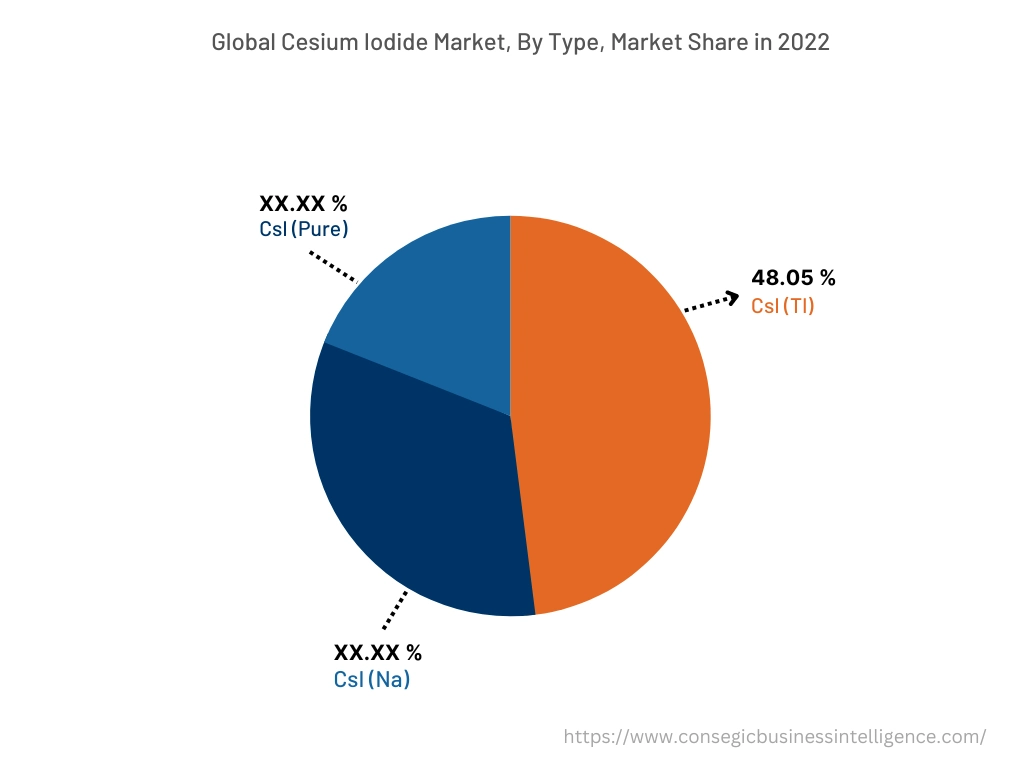
By Application :
The application segment is divided into medical imaging, radiology, optical components, well logging, and others. In 2022, the medical imaging segment held the highest market share in the cesium iodide market. CsI is a preferred material in medical imaging technology due to its properties such as high refractive index and excellent stopping power for medical equipment including X-rays. The increasing demand for diagnostic imaging procedures such as X-rays and CT scans in the healthcare industry is proliferating the growth of the market. For instance, as per the report published by NHS England and NHS Improvement, from 2020 to 2021 August, 40.3 million imaging tests were reported in the United Kingdom. Therefore, the above-mentioned factors are surging the growth of the cesium iodide market.
However, the optical components segment is anticipated to register the fastest CAGR over the forecast period. The wide scope of application of optical components such as optical windows in various end-use industries such as telecommunication and aerospace is expected to drive the demand for cesium iodide.
By End-User :
The end user segment is categorized into healthcare, oil & gas exploration, industrial, and others. In 2022, the healthcare industry held the highest market share in the overall cesium iodide. This is due to the increasing application of cesium iodide as the scintillator material in various medical imaging devices such as X-ray, CT, and PET, among others. For instance, according to the recent statistics published by International Trade Administration (ITA), in 2019, the production of medical devices in Mexico was valued at USD 15.27 billion, and in 2020, it was USD 16.8 billion, an increase of 10%. Thus, the growth of the healthcare industry is contributing to the growth of the segment.
Moreover, the industrial segment is anticipated to register the fastest CAGR over the forecast period. This is due to the rising application of cesium iodide for the production of various components such as optical windows prisms and lenses by various other end use industries. The increasing demand for these cesium iodide-based products is anticipated to accelerate the growth of the segment.
By Region :
The regional segment includes North America, Europe, Asia Pacific, Middle East and Africa, and Latin America.
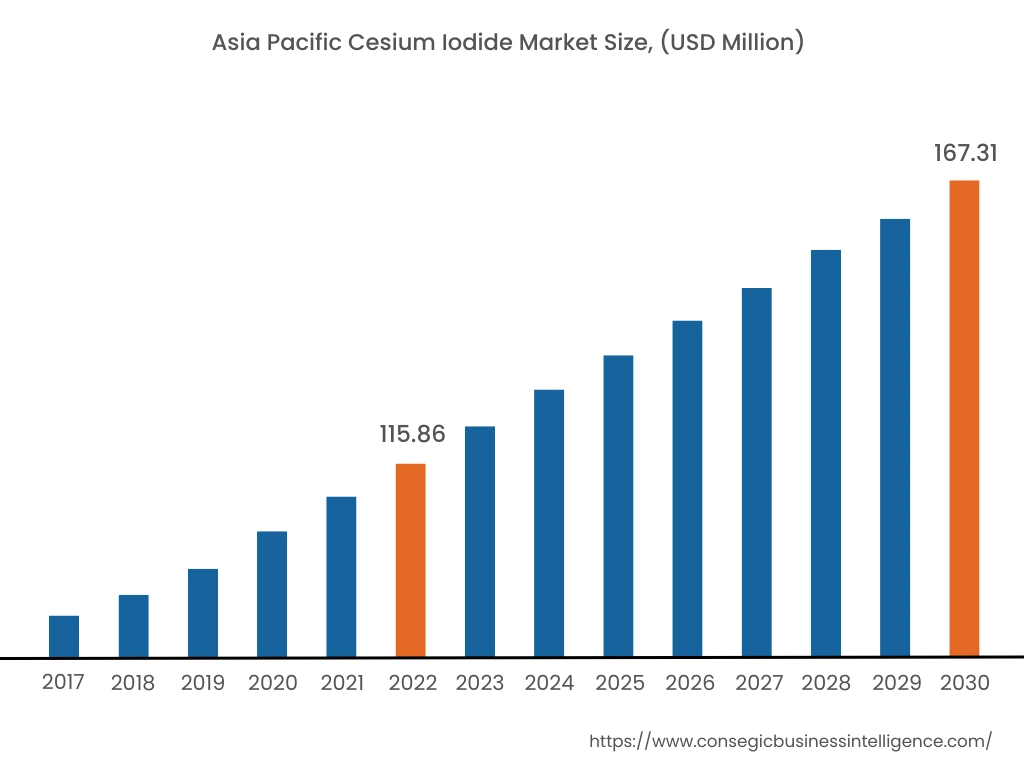
In 2022, Asia Pacific accounted for the highest market share at 38.55% and was valued at USD 115.86 million, and is expected to reach USD 167.31 million in 2030. In Asia Pacific, China accounted for the highest market share of 22.10% during the base year of 2022. The rising expenditures in the healthcare industry is expected to surge the demand for cesium iodide. For instance, according to the report published by the Ministry of Finance, India, the healthcare expenditure in 2021 accounted for INR 807 billion (USD 10.91) and is expected to increase to INR 862 (USD 10.48) in 2023. In addition, the rising prevalence of diseases such as infectious diseases, dental diseases, and cardiovascular disease is anticipated to drive the cesium iodide market.
However, North America is expected to register the fastest CAGR of 5.2% during the forecast period. The well-developed healthcare infrastructure in the region is contributing to the growth of the cesium iodide market. In addition, the increasing adoption of advanced medical technology and equipment is also proliferating market growth.
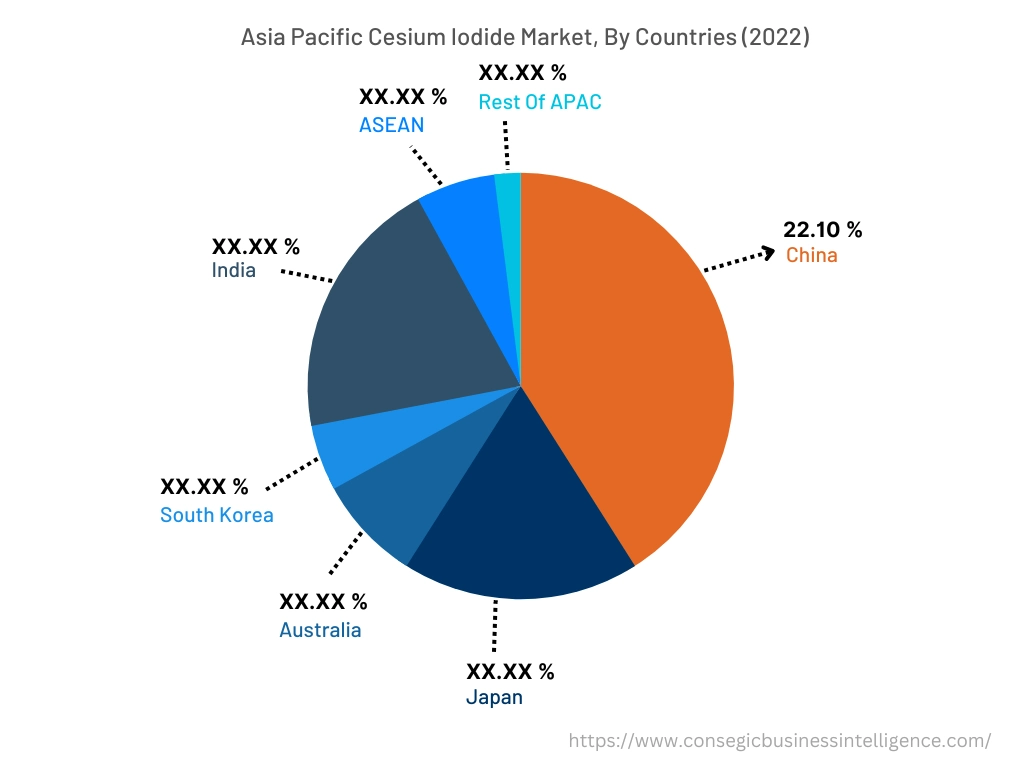
Top Key Players & Market Share Insights :
The cesium iodide market is highly competitive, with several large players and numerous small and medium-sized enterprises. These companies have strong research and development capabilities and a strong presence in the market through their extensive product portfolios and distribution networks. The market is characterized by intense competition, with companies focusing on expanding their product offerings and increasing their market share through mergers, acquisitions, and partnerships. The key players in the market include-
- TCI Chemicals Pvt. Ltd.
- Merck KGaA
- Saint Gobain S.A.
- EPIC Crystal Company Limited
- Shanghai SICCAS
- BERKELEY NUCLEONICS CORPORATION
- Radiation Monitoring Devices
- Amcrys
- Hamamatsu Photonics K.K.
- Scintacor
Recent Industry Developments :
- In September 2021, Saint-Gobain acquired GCP Applied Technologies which is headquartered in Germany. GCP Applied Technologies is involved in the manufacturing of cesium iodide.
Key Questions Answered in the Report
What was the market size of the cesium iodide industry in 2022? +
In 2022, the market size of cesium iodide was USD 300.94 million
What will be the potential market valuation for the Cesium Iodide industry by 2030? +
In 2030, the market size of cesium iodide will be expected to reach USD 433.12 million.
What are the key factor driving the growth of the cesium iodide market? +
Increasing demand for cesium iodide in the healthcare industry is the key factor driving the growth of the cesium iodide market.
What is the dominating segment in the cesium iodide market by type? +
In 2022, the CsI (Tl) segment accounted for the highest market share of 48.75% in the overall cesium iodide market.
Based on current market trends and future predictions, which geographical region will have the fastest impact on the Cesium Iodide market's growth in the coming years? +
North America is expected to be the fastest-growing region in the market during the forecast period.
